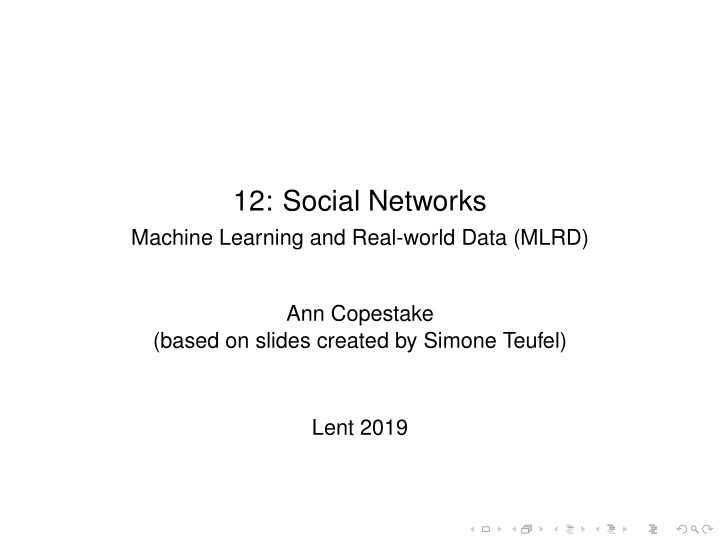



12: Social Networks Machine Learning and Real-world Data (MLRD) Ann Copestake (based on slides created by Simone Teufel) Lent 2019
Where have we got to? You have now encountered two applications of ML and real-world data: Sentiment Detection Sequence learning for biological applications We will now move to the third topic: Social Networks. You will be given a network consisting of users and links between them. You will visualise this network and then write code to determine some simple statistics of the network. In subsequent sessions, we will use network properties in a classic ML task: clustering .
Overview of tasks Task 10: simple statistics including the degree of each node and the diameter of the network. Task 11: finding gatekeeper nodes via betweenness centrality . Task 12: using betweenness centrality of edges to split graph into cliques (example of clustering). Reading for social networks (all sessions): Easley and Kleinberg for background: Chapters 1, 2, 3 and first part of Chapter 20. Brandes algorithm: two papers by Brandes (links in practical notes).
Social networks Examples: Facebook-style networks: Nodes: people; Links: “friend”, messages Twitter-style networks: Nodes: Entities/people Links: “follows”, “retweets” Also: research citations Operations on such networks Which role does a node play in this network? Is there a substructure in the network? neighbourhood areas/cliques
Some reasons to analyse social networks Academic investigation of human behaviour (sociology, economics etc) Disease transmission in epidemics. Modelling information flow: e.g., who sees a picture, reads a piece of news (or fake news). Identifying links between subcommunities, well-connected individuals: recommending research papers to beginning PhD students targeted advertising . . . Lots of applications in conjunction with other approaches: e.g., sentiment analysis of tweets plus network analysis.
Erdös Number Steps in a path between a researcher and the mathematician, Paul Erdös, counting co-authorship of papers as links. http://oakland.edu/enp/
Network concepts illustrated by co-authorship Networks are modelled as graphs: undirected and unweighted here. (weight and direction for co-authorship?) The degree of a node is the number of neighbours a node has in the graph (here co-authors). Erdös is represented as a node of degree 509. The distribution of node degrees may be very skewed: American Mathematical Society data from 2004: http://oakland.edu/enp/ mean degree is 3.36 about 20% have degree 0 (i.e., no co-authored papers) only five mathematicians had more than 200 collaborators, none beside Erdös had more than 270 Most scientific fields can be linked to Erdös, mostly via small number of interdisciplinary authors.
Diameter and average distance of a network distance is the length of shortest path between two nodes. diameter of a graph: maximum distance between any pair of nodes. small world phenomenon , six degrees of separation ’Chain-links’: short story by Karinthy (1929): any two individuals in the world could be connected via at most 5 personal acquaintances. Milgram attempted to verify experimentally (partial success). Natural networks tend to have closely clustered regions, connected only by a few links between them. Often these are weak ties .
Some important concepts for social networks See Easley and Kleinberg (2010, Chapter 3) for full discussion: giant component : a connected component containing most of the nodes in a graph. weak and strong ties : the closeness of the link. e.g., two researchers co-author lots of papers together, or co-authors on one paper (with other people)? Large components often only connected by weak ties.
Bridge bridge : an edge that connects two components which would otherwise be unconnected. Figure 3.3 from Easley and Kleinberg (2010)
Local bridge local bridge : an edge joining two nodes that have no other neighbours in common. Cutting a local bridge increases the length of the shortest path between the nodes. Figure 3.4 from Easley and Kleinberg (2010)
Triadic closure and clustering coefficient Easley and Kleinberg (2010, p48–50) triadic closure : triangle of nodes. Thought of as a dynamic property: if A knows B and A knows C, relatively likely B and C will (get to) know each other. The clustering coefficient is a measure of the amount of triadic closure in a network. Clustering coefficient of a node A is the probability that two randomly selected neighbours of A are also neighbours of each other.
Small worlds (Easley and Kleinberg, Ch 20) Is the small world phenomenon surprising? Short paths not surprising if links fan out enough at each step — we quickly reach everyone in the world. But, for small world, links must be found (to an extent) by humans: decentralized search. And fan out isn’t what really happens: triadic closure . In fact, long weak ties are crucial.
Random graph generation for experimental investigation Figure 20.3 from Easley and Kleinberg (2010) Watts and Strogatz: randomly generated graph with triangles at close range, plus a few long random links. Random links generated according to inverse square of distance between nodes. These allow the reduction of distance to target.
Today’s data Facebook data: combined friends list data from 10 users ( ego-networks ). Originally used for experiments in discovering social circles : e.g., family, school friends, university friends, CS department friends (contained completely in university friends). http://snap.stanford.edu/data/ egonets-Facebook.html Also available today for the starred tick: two collaboration networks (also from SNAP).
Your task today Task 10: Investigate the network using Gephi Visualize the network with Gephi Find network diameter Visualize node degrees Visualize betweenness centrality (discussed in a later lecture) Coding: Find the degree of each node. Determine the diameter of the network using a breadth-first all-pairs shortest path (APSP) algorithm. (More complex approaches in Algorithms course, but note there are no weights or negative edges here.)
Recommend
More recommend